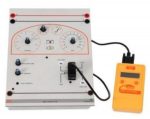Onboard Diagnosis II simulator

This course demonstrates how to read out emission data with the help of the onboard diagnosis unit (OBD II or
EOBD), interpret the data and use the results as a basis for eliminating systemic faults. Students have the
possibility to adjust various parameters on their own to see how these settings affect the tester. They also have
the opportunity to tap the CAN transmission signal to display it on the oscilloscope.
- Original OBDII/EOBD interface
- CAN interface
- Fault simulation switches
- Current vehicle data can be modified and read, including air
flow, engine temperature, speed and rev count - Inputs/outputs: 4mm sockets
- 2 Safety connection plugs, red, 19/4mm
- 1 Safety connection plugs, black, 19/4mm
- Dimensions: 297 x 228 x 70mm
- Weight: 1.2kg
- What is OBD?
- Requirements concerning OBD II and EOBD
- Differences from OBD I
- Differences between OBD II and EOBD
- Fault display
- Driving cycle
- Diagnostics interface
- Protocols
- Fault codes
- Readiness code
- Summary of EOBD
- OBD knowledge test
- Diagnostic unit
- Functions of a diagnostic unit
- Diamex operation
- Diamex operation – part 2
- Launch CRecoder
- Simulator tests

